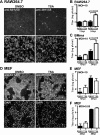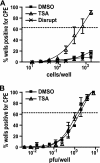Histone deacetylases and the nuclear receptor corepressor regulate lytic-latent switch gene 50 in murine gammaherpesvirus 68-infected macrophages
- PMID: 20719946
- PMCID: PMC2977890
- DOI: 10.1128/JVI.00396-10
Histone deacetylases and the nuclear receptor corepressor regulate lytic-latent switch gene 50 in murine gammaherpesvirus 68-infected macrophages
Abstract
Gammaherpesviruses are important oncogenic pathogens that transit between lytic and latent life cycles. Silencing the lytic gene expression program enables the establishment of latency and a lifelong chronic infection of the host. In murine gammaherpesvirus 68 (MHV68, γHV68), essential lytic switch gene 50 controls the interchange between lytic and latent gene expression programs. However, negative regulators of gene 50 expression remain largely undefined. We report that the MHV68 lytic cycle is silenced in infected macrophages but not fibroblasts and that histone deacetylases (HDACs) mediate silencing. The HDAC inhibitor trichostatin A (TSA) acts on the gene 50 promoter to induce lytic replication of MHV68. HDAC3, HDAC4, and the nuclear receptor corepressor (NCoR) are required for efficient silencing of gene 50 expression. NCoR is critical for transcriptional repression of cellular genes by unliganded nuclear receptors. Retinoic acid, a known ligand for the NCoR complex, derepresses gene 50 expression and enhances MHV68 lytic replication. Moreover, HDAC3, HDAC4, and NCoR act on the gene 50 promoter and are recruited to this promoter in a retinoic acid-responsive manner. We provide the first example of NCoR-mediated, HDAC-dependent regulation of viral gene expression.
Figures






Similar articles
-
Virus-encoded microRNAs facilitate gammaherpesvirus latency and pathogenesis in vivo.mBio. 2014 May 27;5(3):e00981-14. doi: 10.1128/mBio.00981-14. mBio. 2014. PMID: 24865551 Free PMC article.
-
Lytic Replication and Reactivation from B Cells Is Not Required for Establishing or Maintaining Gammaherpesvirus Latency In Vivo.J Virol. 2022 Jun 22;96(12):e0069022. doi: 10.1128/jvi.00690-22. Epub 2022 Jun 1. J Virol. 2022. PMID: 35647668 Free PMC article.
-
Rta of murine gammaherpesvirus 68 reactivates the complete lytic cycle from latency.J Virol. 2000 Apr;74(8):3659-67. doi: 10.1128/jvi.74.8.3659-3667.2000. J Virol. 2000. PMID: 10729142 Free PMC article.
-
Lytic cycle switches of oncogenic human gammaherpesviruses.Adv Cancer Res. 2007;97:81-109. doi: 10.1016/S0065-230X(06)97004-3. Adv Cancer Res. 2007. PMID: 17419942 Review.
-
Getting the message direct manipulation of host mRNA accumulation during gammaherpesvirus lytic infection.Adv Virus Res. 2010;78:1-42. doi: 10.1016/B978-0-12-385032-4.00001-X. Adv Virus Res. 2010. PMID: 21040830 Review.
Cited by
-
Th2 Cytokine Modulates Herpesvirus Reactivation in a Cell Type Specific Manner.J Virol. 2021 Mar 25;95(8):e01946-20. doi: 10.1128/JVI.01946-20. Epub 2021 Feb 3. J Virol. 2021. PMID: 33536178 Free PMC article.
-
Primary macrophages rely on histone deacetylase 1 and 2 expression to induce type I interferon in response to gammaherpesvirus infection.J Virol. 2014 Feb;88(4):2268-78. doi: 10.1128/JVI.03278-13. Epub 2013 Dec 11. J Virol. 2014. PMID: 24335310 Free PMC article.
-
Gammaherpesviral gene expression and virion composition are broadly controlled by accelerated mRNA degradation.PLoS Pathog. 2014 Jan;10(1):e1003882. doi: 10.1371/journal.ppat.1003882. Epub 2014 Jan 16. PLoS Pathog. 2014. PMID: 24453974 Free PMC article.
-
A conserved gammaherpesvirus protein kinase targets histone deacetylases 1 and 2 to facilitate viral replication in primary macrophages.J Virol. 2013 Jul;87(13):7314-25. doi: 10.1128/JVI.02713-12. Epub 2013 Apr 24. J Virol. 2013. PMID: 23616648 Free PMC article.
-
Amino acid starvation induces reactivation of silenced transgenes and latent HIV-1 provirus via down-regulation of histone deacetylase 4 (HDAC4).Proc Natl Acad Sci U S A. 2012 Aug 21;109(34):E2284-93. doi: 10.1073/pnas.1202174109. Epub 2012 Jul 23. Proc Natl Acad Sci U S A. 2012. PMID: 22826225 Free PMC article.
References
-
- Bolden, J. E., M. J. Peart, and R. W. Johnstone. 2006. Anticancer activities of histone deacetylase inhibitors. Nat. Rev. Drug Discov. 5:769-784. - PubMed
-
- Caselli, E., M. Galvan, F. Santoni, S. Alvarez, A. R. de Lera, D. Ivanova, H. Gronemeyer, A. Caruso, M. Guidoboni, E. Cassai, R. Dolcetti, and L. D. Di. 2008. Retinoic acid analogues inhibit human herpesvirus 8 replication. Antivir. Ther. 13:199-209. - PubMed
-
- Deng, H., Y. Liang, and R. Sun. 2007. Regulation of KSHV lytic gene expression. Curr. Top. Microbiol. Immunol. 312:157-183. - PubMed
Publication types
MeSH terms
Substances
Grants and funding
LinkOut - more resources
Full Text Sources
Research Materials

